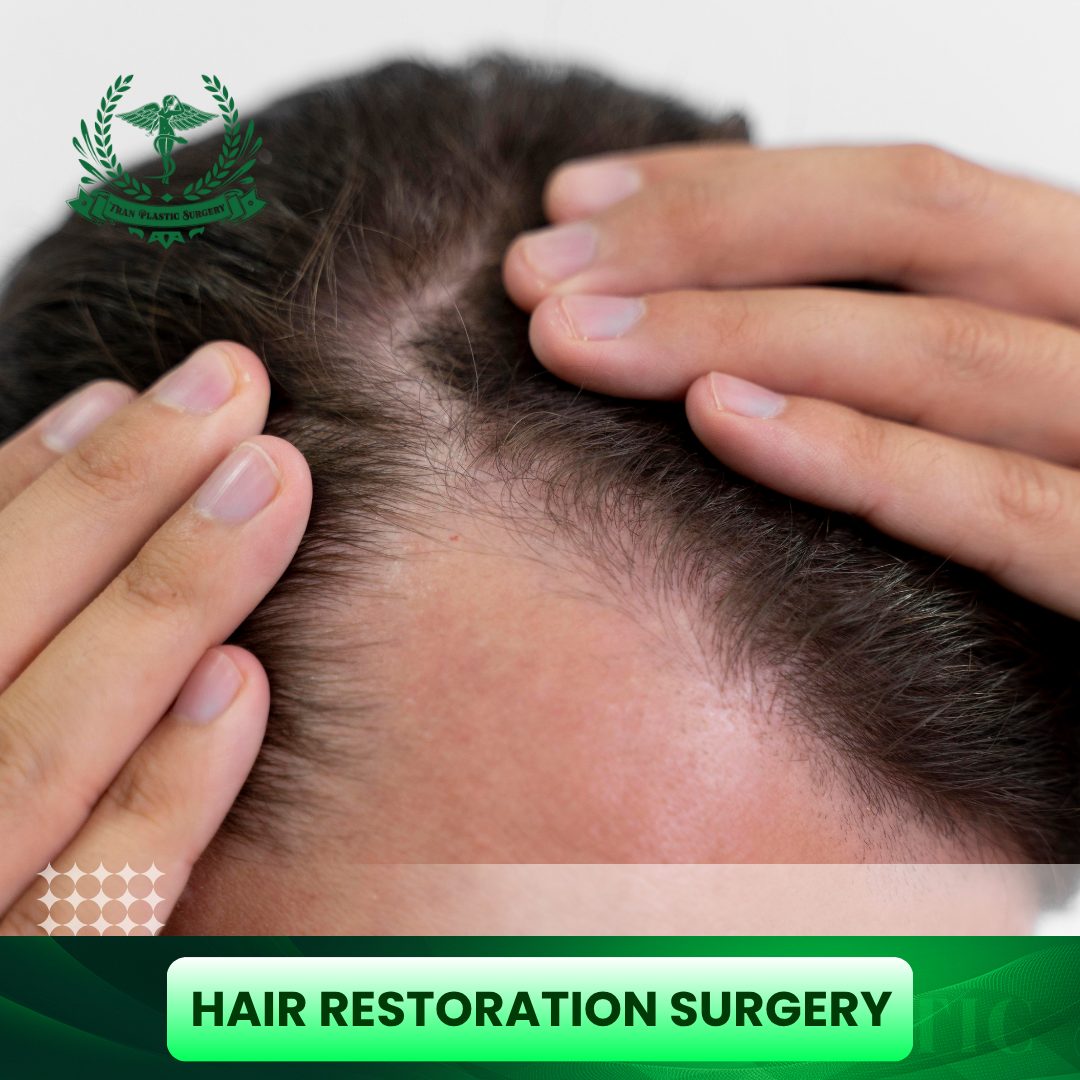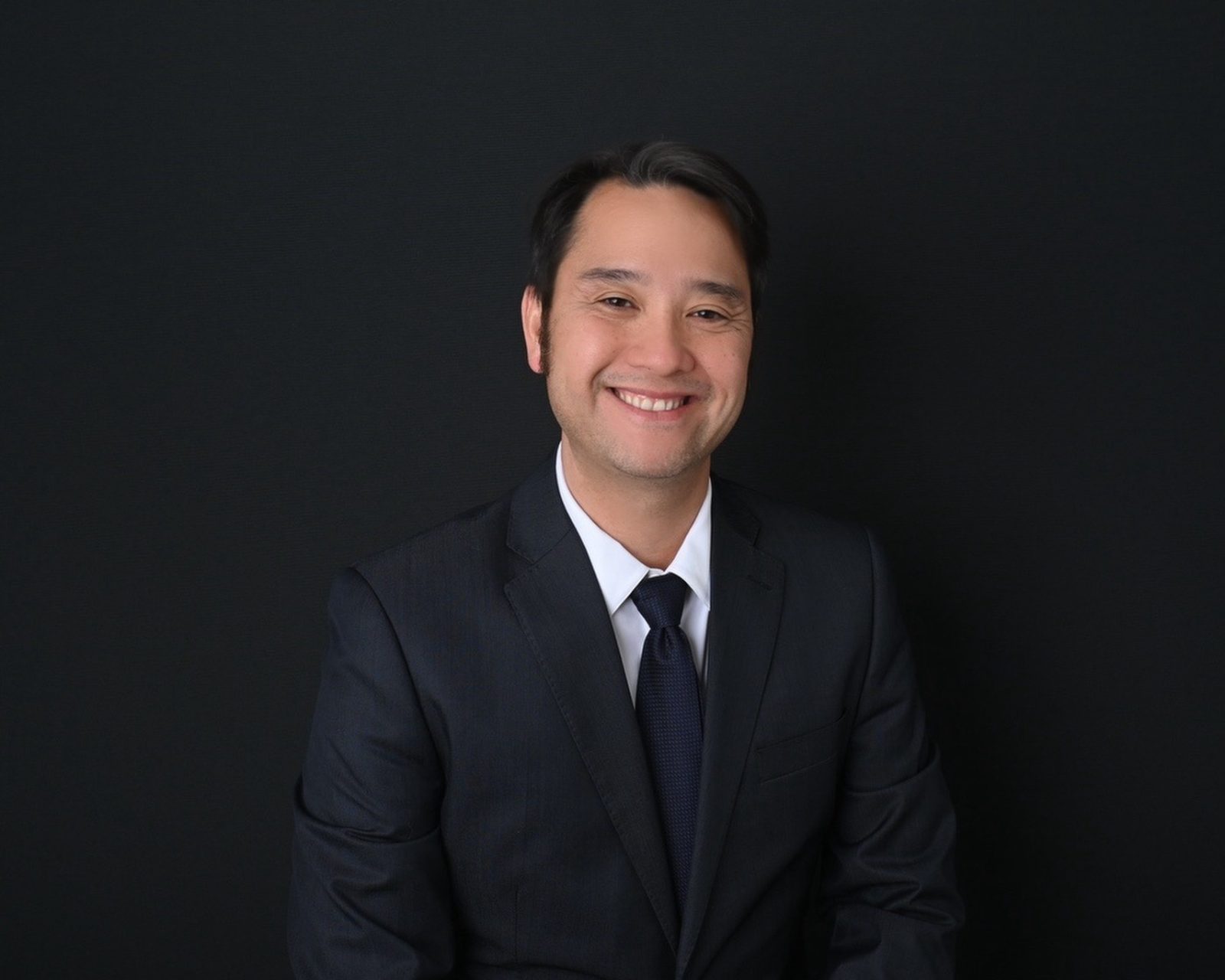Hair restoration surgery is more than a cosmetic procedure, it’s a lifeline for those silently battling the daily stress of hair loss. Every strand that falls can feel like a piece of confidence slipping away, and no shampoo, supplement, or serum seems to stop it. That quiet anxiety in front of the mirror, the self-conscious glance in photos, the hesitation in social moments, it all adds up. This is where modern hair restoration surgery steps in, offering not just renewed hair growth, but a powerful restoration of self-image and certainty.
In this guide, Tran Plastic Surgery helps you learn exactly how the procedure works, who it’s for, what results to expect, how much it costs, and why choosing the right surgeon determines whether your transformation feels natural, permanent, and life-changing.
Table of Contents
ToggleWhat Is Hair Restoration Surgery?
Hair restoration surgery is a specialized medical procedure designed to permanently restore hair in areas affected by thinning or baldness. Unlike topical products or temporary treatments, this technique transfers healthy hair follicles from donor areas, typically the back or sides of the scalp to regions where hair growth has stopped. Once transplanted, these follicles continue to grow naturally, producing new strands that blend seamlessly with your existing hair.
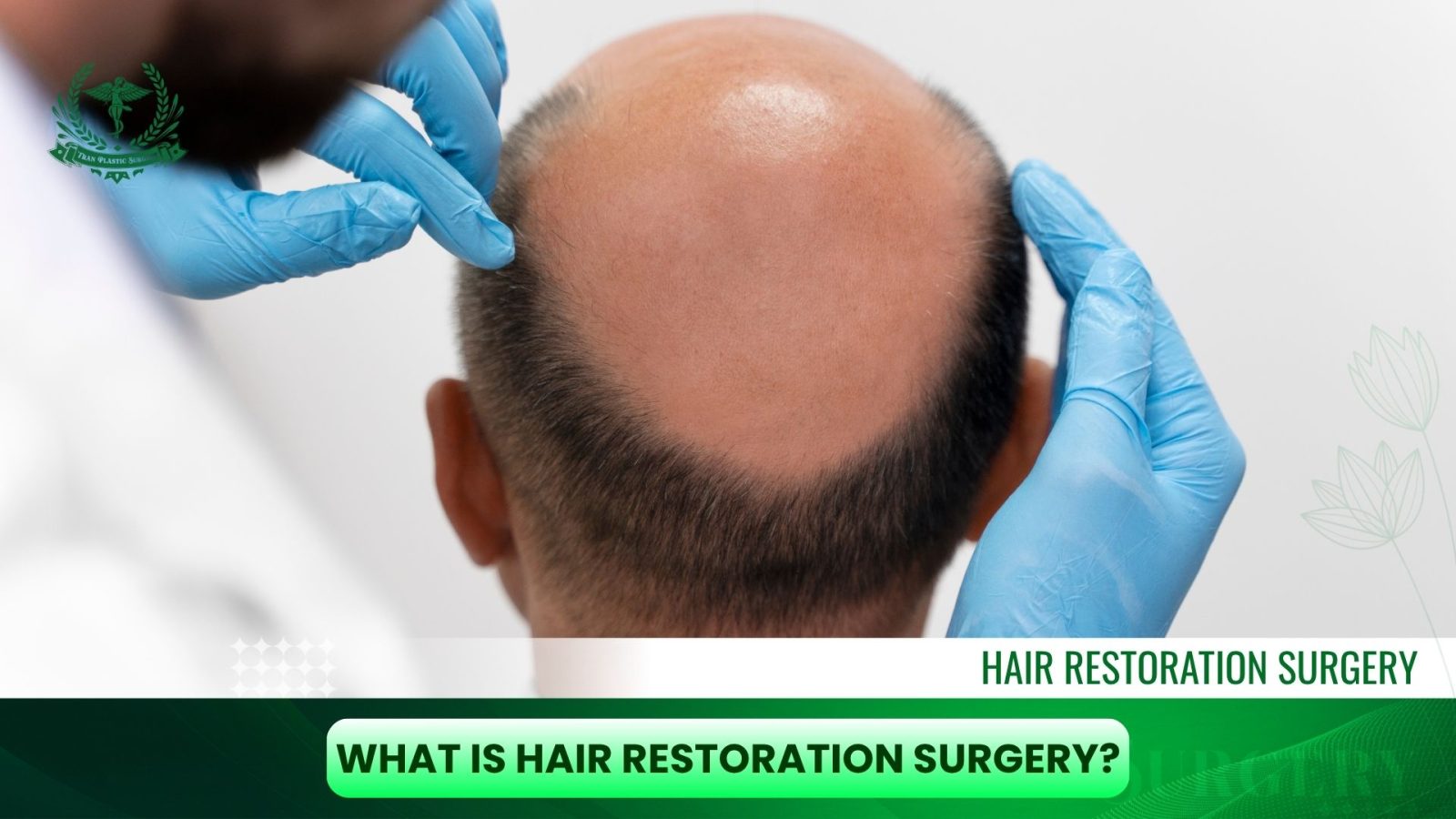
Modern hair restoration methods, such as Follicular Unit Extraction (FUE) and Follicular Unit Transplantation (FUT), have transformed the field. These advanced techniques minimize visible scarring, reduce recovery time, and deliver results that look and feel entirely natural. Many patients also choose to combine PRP (Platelet-Rich Plasma) therapy with surgery to accelerate healing and stimulate stronger hair growth.
In essence, hair restoration surgery is not just about regaining hair, it’s about restoring confidence, youthfulness, and self-esteem. When performed by a qualified hair restoration surgeon, it becomes a safe, reliable solution for both men and women who are ready for a permanent transformation.
>>> Related post: Hair Transplant And Medical Treatment For Hair Growth
Who Is a Good Candidate for Hair Restoration Surgery?
Not everyone experiencing hair loss requires surgery, but hair restoration surgery can be a life-changing solution for the right individual. Below are the key factors that define an ideal candidate:
- Experience male or female pattern baldness or progressive hair thinning.
- Have healthy donor hair on the back or sides of the scalp for transplantation.
- Are over 25 years old, with hair loss that has stabilized.
- Are in good general health and free from medical conditions that affect healing.
- Have realistic expectations about what the procedure can achieve improved coverage and natural-looking density.
- Feel emotionally affected by hair loss and are ready to restore your confidence and self-image.
- Are seeking a permanent solution rather than temporary treatments or concealers.
- Are open to complementary therapies such as PRP (Platelet-Rich Plasma) or non-surgical hair restoration to enhance results.
If you’re unsure whether you qualify, a consultation with a certified hair restoration surgeon will help determine the best approach for your condition and goals.
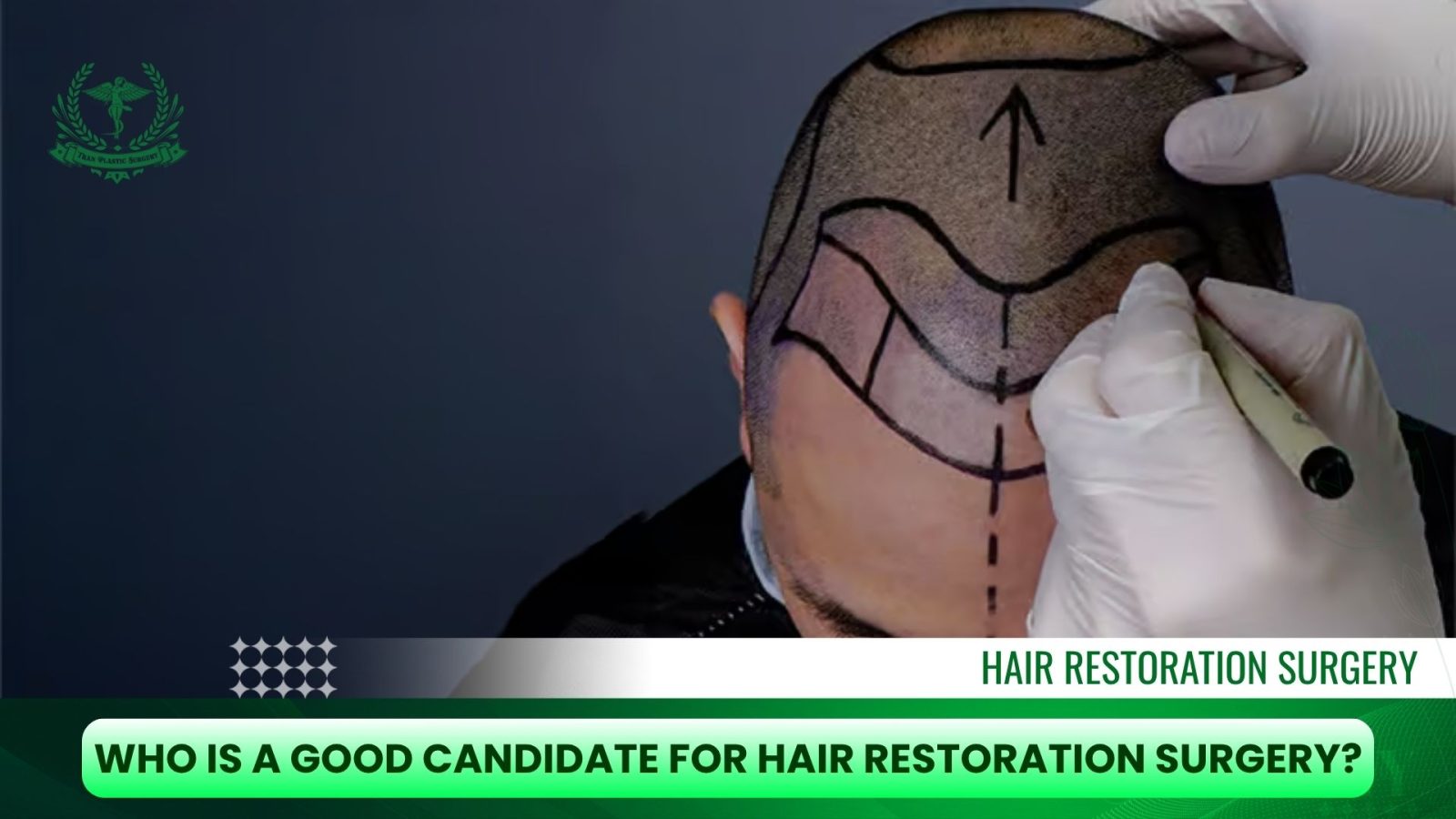
How Hair Restoration Surgery Works
Understanding how hair restoration surgery works helps patients feel confident about their decision and what to expect. The process begins with a detailed consultation, during which the hair restoration surgeon evaluates the pattern of hair loss, the quality of donor hair, and the patient’s goals. This assessment allows the surgeon to create a customized treatment plan tailored to natural facial proportions and future hair growth patterns.
The procedure itself typically follows one of two main techniques: Follicular Unit Transplantation (FUT) or Follicular Unit Extraction (FUE).
- FUT (Strip Method): A thin strip of scalp containing healthy hair follicles is removed from the donor area, and individual follicular units are separated and transplanted into thinning regions. This method can be ideal for patients needing higher graft counts in a single session.
- FUE (Follicular Unit Extraction): Individual hair follicles are extracted directly from the donor site using micro-punch instruments, leaving minimal scarring and allowing for faster recovery. It’s often preferred by patients seeking a shorter downtime and the ability to wear shorter hairstyles.
After transplantation, each follicle settles into its new site and begins to grow naturally over the following months. Within three to four months, new hair emerges, gradually thickening and blending with the existing strands. Many patients enhance their outcome by combining the surgery with PRP therapy, which uses growth factors from their own blood to stimulate stronger, faster hair growth.
Hair restoration surgery is typically performed under local anesthesia and completed within several hours, depending on the number of grafts required. Most individuals return to their regular activities within a few days, with visible results developing progressively over the next 9–12 months.
Cost of Hair Restoration Surgery
The average cost of hair restoration surgery ranges from $500 to $15,000+. The cost also depends on a number of factors, including the type of technique used, the size of the area being treated, and the expertise of the surgeon. Although prices may vary from clinic to clinic, knowing the general cost range will help patients feel more confident when planning their investment.
Average Cost Breakdown
| Procedure Type | Estimated Cost Range (USD) | Key Details / Notes |
| FUE (Follicular Unit Extraction) | $5,000 – $15,000 | Minimally invasive; individual follicles extracted and transplanted; higher precision and cost per graft. |
| FUT (Follicular Unit Transplantation) | $4,000 – $10,000 | Traditional strip method; efficient for covering larger areas; may leave a fine linear scar. |
| PRP (Platelet-Rich Plasma) Add-On | $500 – $2,000 per session | Enhances graft healing and stimulates stronger hair growth. Often used alongside surgery. |
| Minor / Partial Sessions | $2,000 – $4,000 | Suitable for smaller bald patches or touch-ups. |
| Comprehensive Full-Scale Restoration | $10,000 – $15,000+ | Full crown or advanced pattern baldness restoration; custom plan based on graft count. |
*Note: Prices vary depending on clinic location, surgeon experience, graft quantity, and individual scalp condition. A detailed quote is always provided after consultation.
Choosing a qualified hair restoration surgeon ensures the investment brings long-term, natural results. While lower prices may appear attractive, inexperienced or unlicensed providers often compromise on graft quality, density, and aesthetic outcome leading to costly corrections later.
At Tran Plastic Surgery, patients receive transparent pricing and personalized treatment plans. Financing options are available to make hair restoration surgery more accessible without sacrificing quality or safety.
Recovery, Results, and What to Expect After Hair Restoration Surgery
Recovering from hair restoration surgery is typically simple and comfortable when proper care is followed. Most patients return to normal routines within a few days. You may experience mild swelling, tightness, or tenderness on the scalp, but these effects fade quickly under your surgeon’s guidance.
First Week:
Tiny scabs form around each graft; this is completely normal. Avoid touching or scratching the scalp. By the end of the first week, most of these crusts fall off naturally.
First Month:
Some of the transplanted hairs will shed. This phase, called “shock loss”, is part of the natural healing cycle. It allows new, stronger hair to begin growing from the transplanted follicles.
Three to Six Months:
You’ll start to notice soft, thin new hairs appearing. They will gradually thicken and blend with your existing hair.
Nine to Twelve Months:
Full results become visible. The restored hairline looks natural, permanent, and harmonious with your facial structure. Most patients describe this stage as truly life-changing.
To enhance growth, many people combine surgery with PRP therapy or maintenance treatments to strengthen follicles and improve scalp circulation. With consistent care, the outcome of hair restoration surgery can last for many years, often a lifetime.
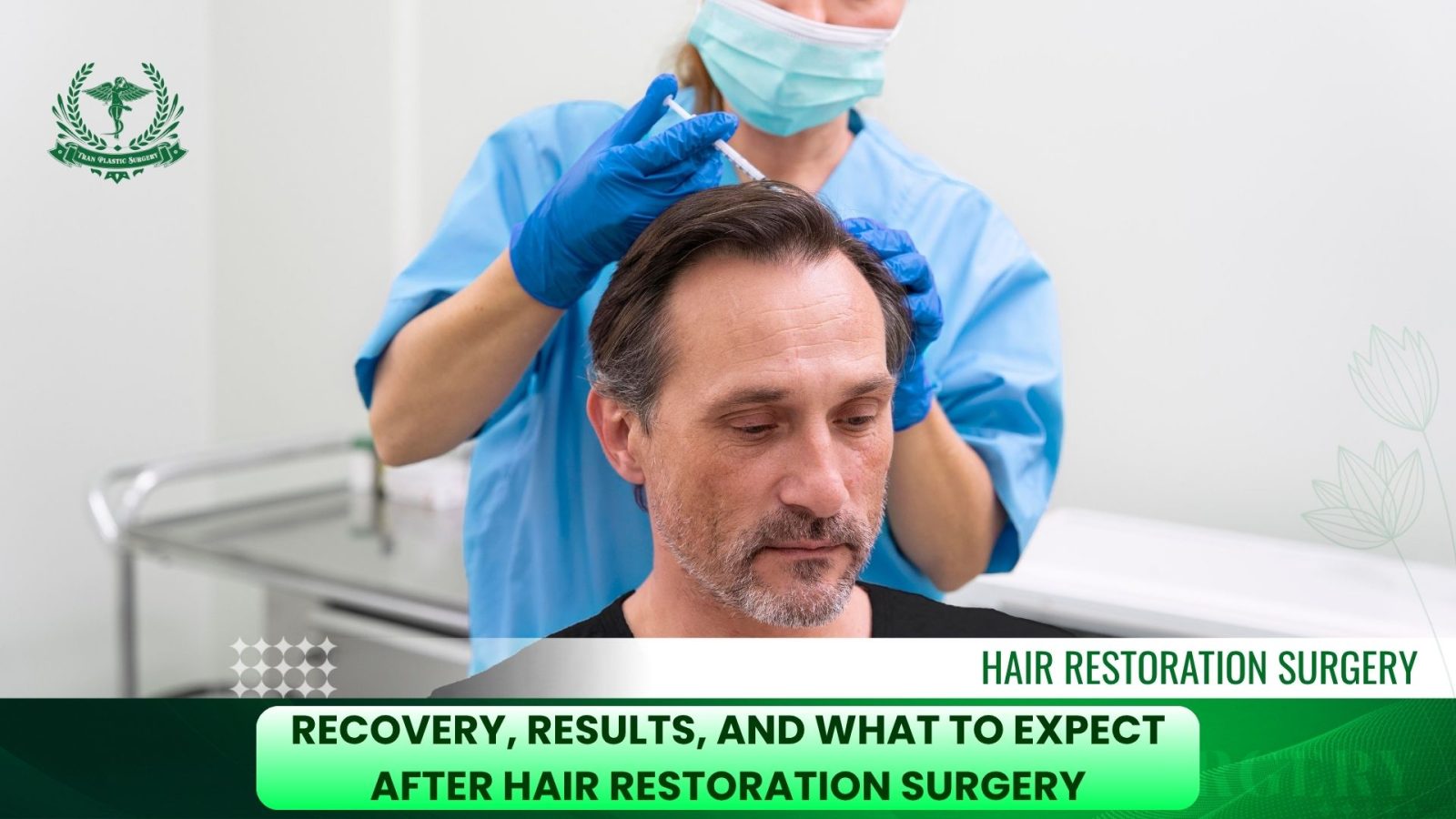
Risks and Safety Considerations of Hair Restoration Surgery
Every surgical procedure carries some level of risk, and hair restoration surgery is no exception. However, when performed by a skilled and board-certified hair restoration surgeon, complications are rare and outcomes are consistently safe and successful.
1. Common and Temporary Side Effects
Most patients experience only mild, short-term side effects that subside within days:
- Swelling or redness of the scalp
- Minor discomfort or tightness in the donor or recipient area
- Scabbing or crusting around grafts, which naturally falls away
- Temporary shedding known as “shock loss” a normal part of the healing phase
These symptoms are easily managed with prescribed medications and proper post-operative care.
2. Potential Risks (When Not Performed Properly)
When hair restoration surgery is done by unqualified or inexperienced providers, patients face avoidable issues such as:
- Uneven hairline design or unnatural direction of growth
- Visible scarring from poor technique
- Infection or delayed healing due to non-sterile environments
- Poor graft survival, leading to thin or patchy results
That’s why choosing a board-certified plastic surgeon or qualified hair restoration specialist is crucial. Accredited clinics follow strict surgical protocols, use sterile instruments, and rely on advanced technology such as microscopic graft preparation and PRP-assisted healing to minimize risk and maximize results.
3. Safety Assurance and Patient Care
At Tran Plastic Surgery, patient safety is always the first priority. Before surgery, each individual undergoes a full medical assessment to ensure candidacy and eliminate potential complications. During and after the procedure, continuous monitoring and precise surgical methods ensure graft survival, comfort, and natural-looking growth.
Before and After Results of Hair Restoration Surgery
The results of hair restoration surgery can be life-changing both in appearance and confidence. Patients often describe their transformation as more than just physical; it’s an emotional renewal that restores how they feel about themselves in social and professional settings.
1. Before the Procedure
Before undergoing hair restoration surgery, most individuals struggle with thinning hair, visible scalp areas, or receding hairlines that make them look older than they feel. This can lead to self-consciousness, reduced confidence, and frustration after trying temporary fixes such as topical treatments or supplements with limited success.
During consultation, the hair restoration surgeon designs a personalized graft plan that complements natural hair patterns, facial symmetry, and future hair growth. Photos are taken before surgery to document the baseline condition, a valuable reference point for tracking progress.
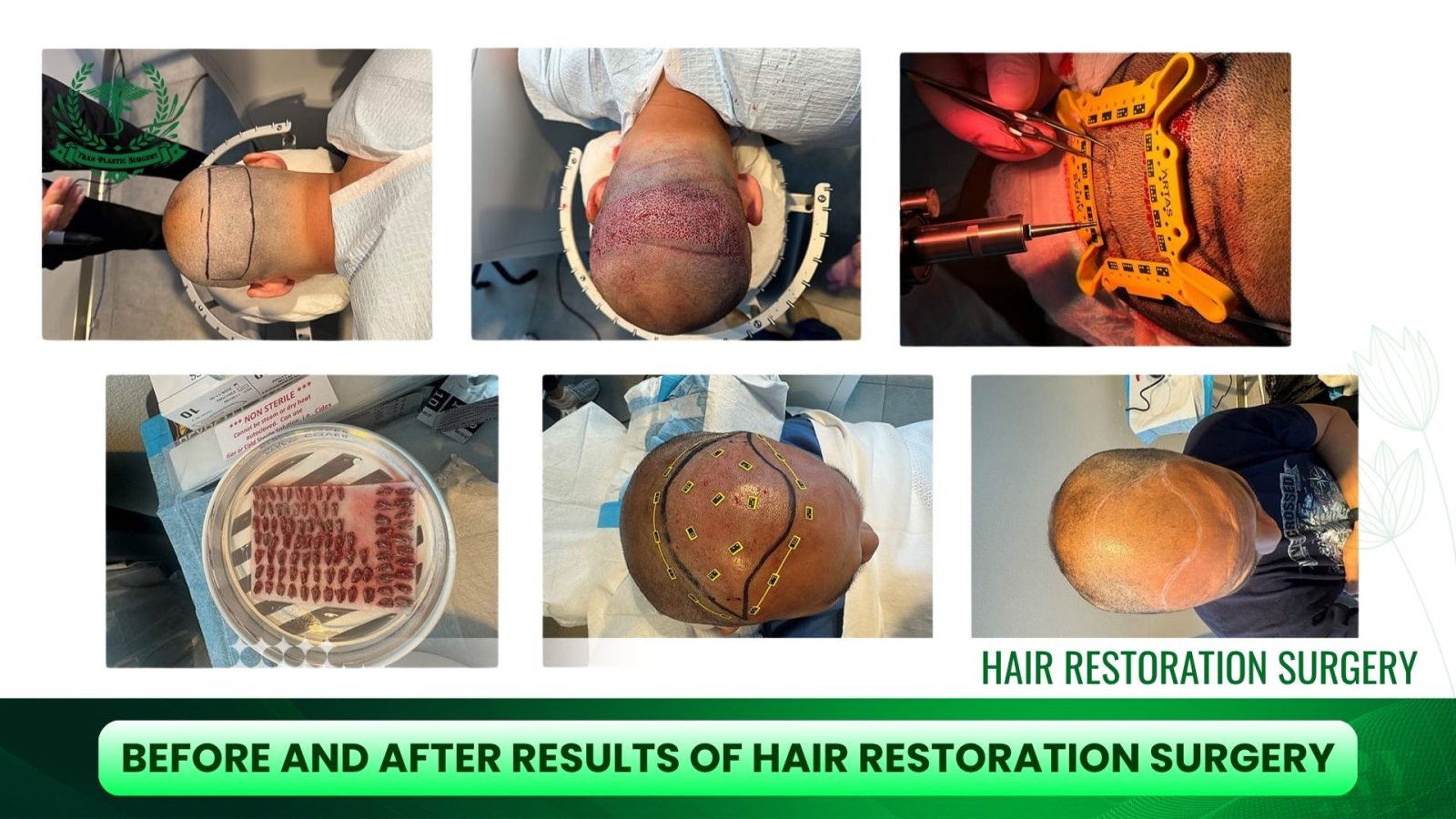
2. After the Procedure
Within several months of surgery, new follicles begin to produce natural strands of hair. The density gradually increases between six to twelve months, creating a thicker, fuller, and more youthful appearance. By the one-year mark, most patients achieve permanent, natural-looking results that are virtually undetectable even under close inspection.
When combined with PRP therapy or ongoing scalp maintenance, results can be enhanced further, improving thickness and long-term follicle strength. Patients frequently express how regaining their hair changes how they carry themselves smiling more, participating in social activities, and feeling renewed pride in their appearance.
3. Visual Proof and Confidence
Tran Plastic Surgery believes that seeing real results builds real confidence. Our before-and-after photo gallery showcases authentic patient transformations, no filters, no retouching. Each image represents the skill of our surgical team and the power of modern hair restoration surgery to restore not just hair, but identity and confidence.
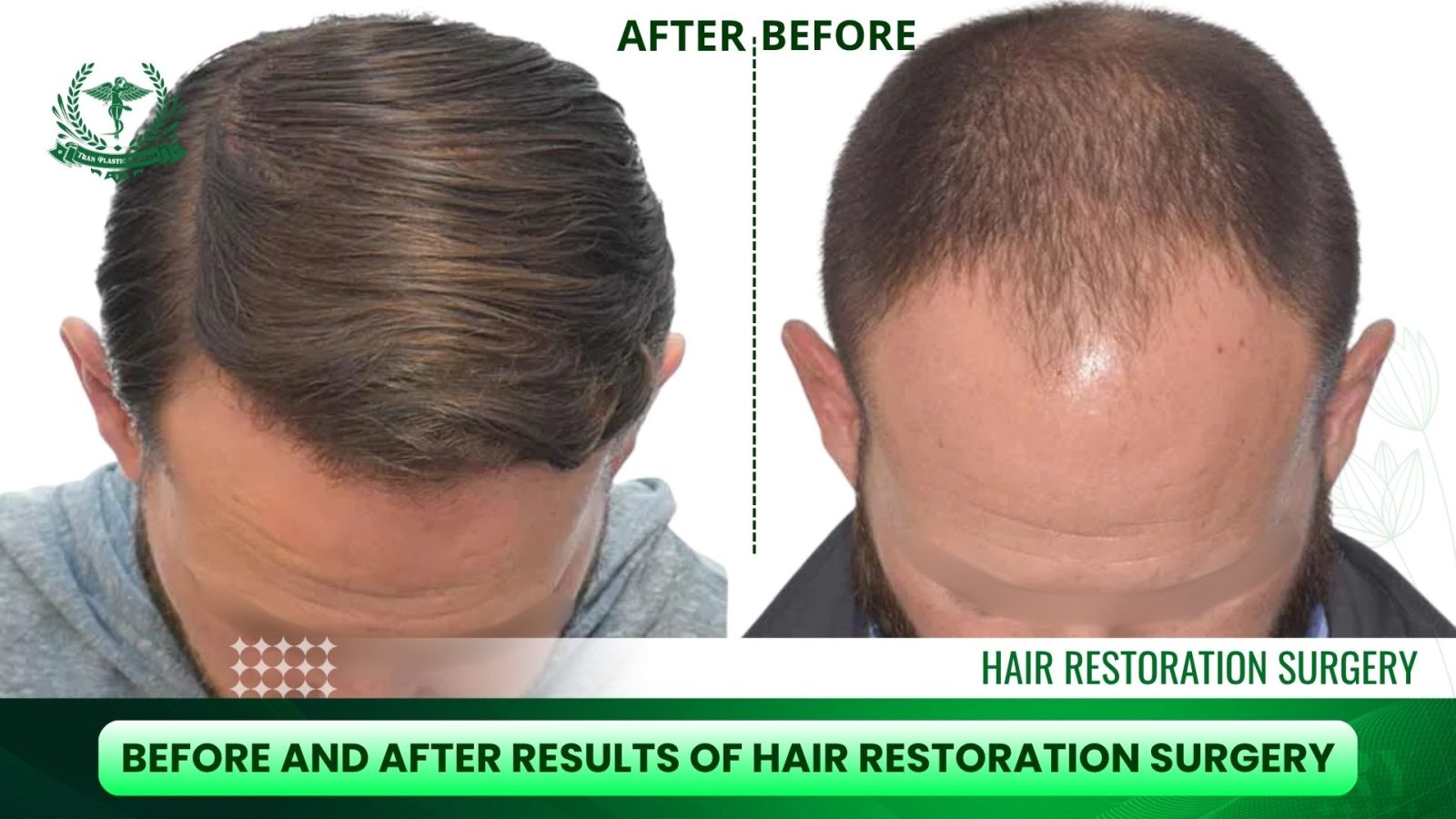
Choosing the Right Hair Restoration Surgeon
Selecting the right hair restoration surgeon determines the difference between an average result and a truly life-changing transformation. While technology and equipment play a role, the artistry and precision of the surgeon define the outcome of every hair restoration surgery.
1. Qualifications and Credentials
A qualified surgeon should be board-certified in plastic or reconstructive surgery and possess specialized training in hair restoration procedures. Look for certifications from recognized medical associations and documented experience in both FUE and FUT techniques. This ensures that the surgeon can recommend the most effective method based on your scalp condition, hair type, and restoration goals.
2. Experience and Artistic Vision
The best outcomes come from professionals who combine surgical expertise with artistic understanding. Designing a natural hairline requires an eye for facial balance, symmetry, and age-appropriate density. During consultation, an experienced hair restoration doctor will evaluate your donor area, discuss your desired outcome, and set realistic expectations for long-term success.
3. Patient Reviews and Case Studies
Patient testimonials, verified reviews, and before-and-after photos reveal a surgeon’s real-world results. A consistent record of positive feedback is a strong indicator of reliability and care. Transparent clinics, like Tran Plastic Surgery, openly share their patient outcomes, showing authenticity and confidence in their work.
4. Consultation and Communication
A trustworthy hair restoration surgeon takes time to answer every question clearly and honestly. They explain the procedure, possible risks, and recovery expectations without exaggeration. Clear communication builds confidence and ensures that the patient feels informed and supported throughout the process.
5. Meet Dr. Tuan Tran – Expertise You Can Trust
At the center of Tran Plastic Surgery is Dr. Tuan Tran, a board-certified plastic surgeon recognized for his meticulous technique and aesthetic vision. With years of hands-on experience in both FUE (Follicular Unit Extraction) and FUT (Follicular Unit Transplantation), Dr. Tran blends surgical precision with an artist’s eye for natural balance and symmetry. His patient-centered approach ensures that every treatment plan reflects each individual’s facial structure, lifestyle, and long-term goals.
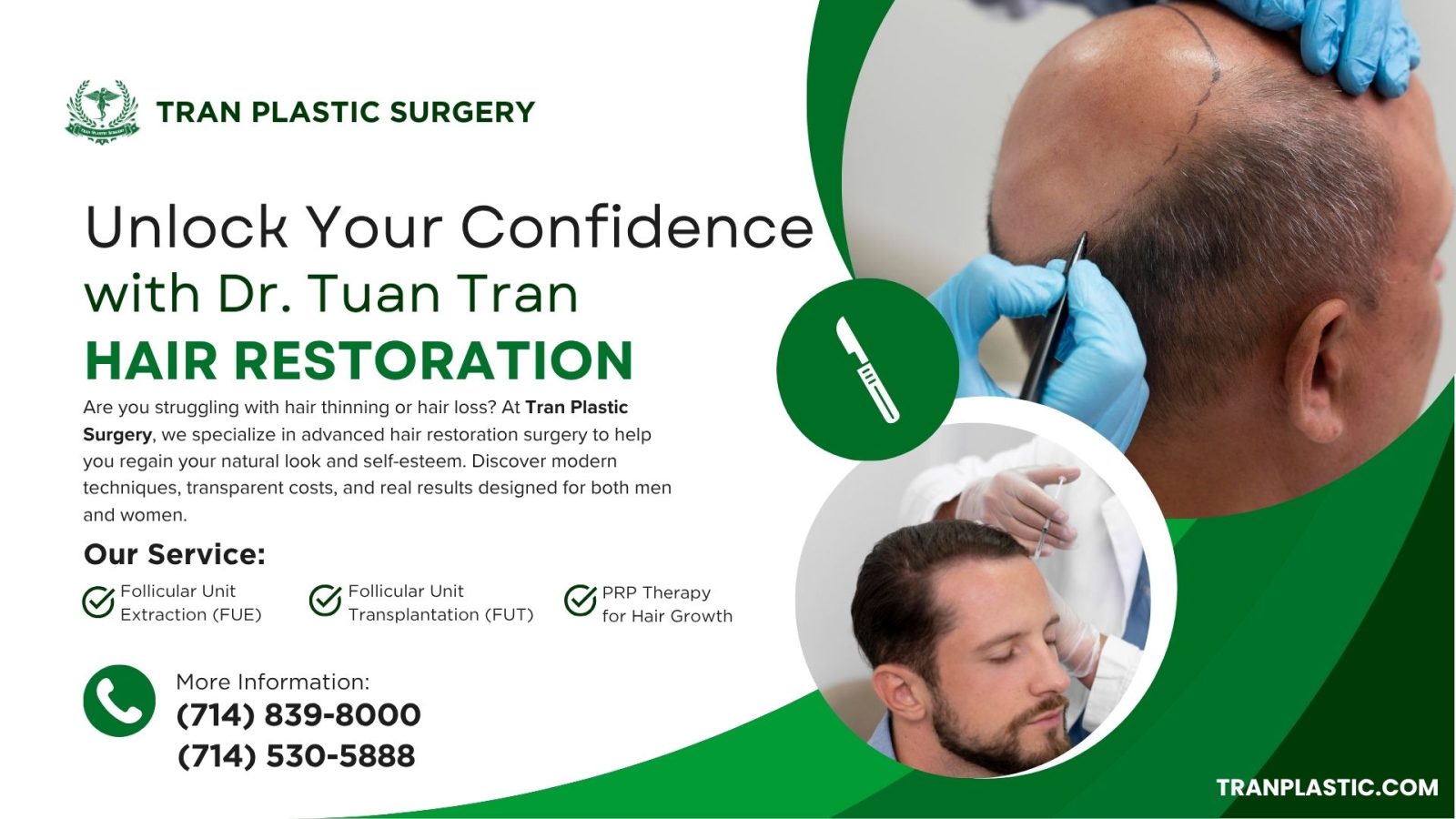
As a board-certified surgeon, Dr. Tran upholds the highest standards of safety and ethics. A trustworthy hair restoration surgeon takes time to answer every question clearly and honestly. They explain the procedure, possible risks, and recovery expectations without exaggeration. Clear communication builds confidence and ensures that the patient feels informed and supported throughout the process.
Conclusion
Hair restoration surgery offers more than visible change, it renews self-confidence and a sense of identity. With the precision of Dr. Tuan Tran, each procedure is customized to look natural, permanent, and refined. Regaining your hair means reclaiming how you see yourself every day confident, assured, and ready to move forward.
*References: The International Society of Hair Restoration Surgery (ISHRS) & https://www.plasticsurgery.org/cosmetic-procedures/hair-transplantation-and-restoration
Frequently Asked Questions About Hair Restoration Surgery
1. Is hair restoration surgery permanent?
Yes. Hair restoration surgery is designed to deliver permanent results. The transplanted follicles are taken from areas genetically resistant to hair loss typically the sides or back of the scalp ensuring they continue to grow naturally for life. However, maintenance treatments or follow-up sessions may be recommended to preserve density as native hair continues to thin over time.
2. Does hair restoration surgery hurt?
The procedure is performed under local anesthesia, so patients remain comfortable throughout. You may feel slight pressure or tingling but not pain. After surgery, mild soreness or tightness can occur for a few days and is easily managed with prescribed medication.
3. How long does the procedure take?
A typical session lasts between 4 to 8 hours, depending on the number of grafts transplanted. Larger procedures or combined treatments, such as PRP therapy, may take longer but are completed in a single day.
4. What is the recovery time?
Most patients return to normal activities within 2 to 5 days. Minor redness and scabbing fade within the first week. Newly transplanted follicles begin growing after three to four months, with visible improvement continuing for up to a year.
5. Are there risks involved?
As with any surgical procedure, hair restoration surgery carries minimal risks when performed by a qualified surgeon. Temporary swelling, redness, or minor infection are possible but rare. Choosing a board-certified surgeon significantly reduces these risks and ensures proper care.
6. What is the difference between FUE and FUT?
- FUE (Follicular Unit Extraction): Individual follicles are removed and transplanted, resulting in minimal scarring and faster recovery.
- FUT (Follicular Unit Transplantation): A thin strip of scalp is harvested, and follicles are separated for transplantation. It’s efficient for larger areas but may leave a fine linear scar.
7. Can women undergo hair restoration surgery?
Yes. Both men and women can benefit from this procedure. For women experiencing diffuse thinning or pattern hair loss, a consultation helps determine whether surgical or non-surgical hair restoration methods are best.
8. How much does hair restoration surgery cost?
The cost of hair restoration surgery typically ranges from $500 to $15,000, depending on the technique, surgeon expertise, and number of grafts required. A personalized consultation provides an accurate estimate based on individual needs and goals.
9. When will I see the final results?
Initial growth begins around the 3-month mark, with full results visible between 9 to 12 months. Each person’s growth cycle is unique, but results are permanent and blend seamlessly with natural hair.

